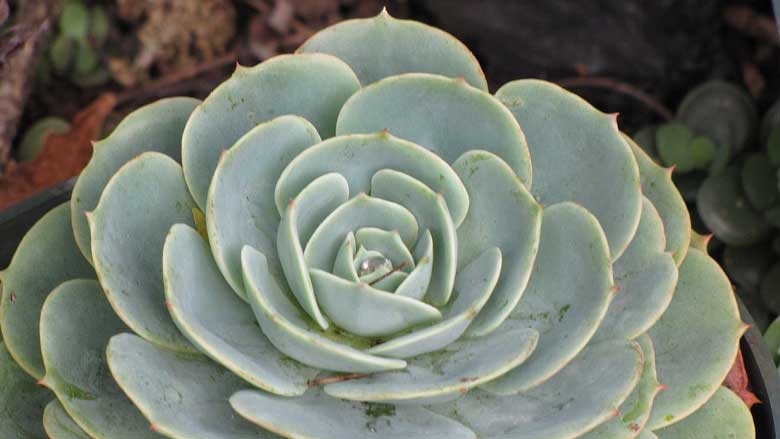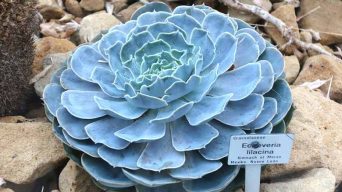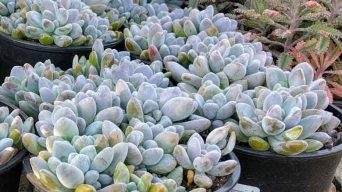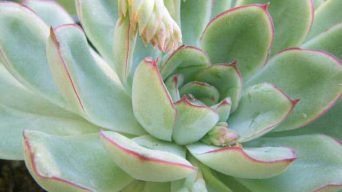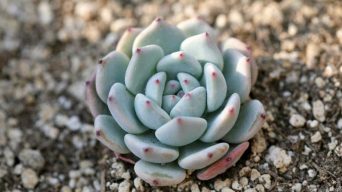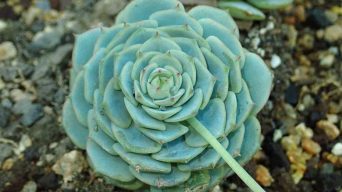Echeveria succulents are a very popular and low-maintenance indoor plant, thriving on neglect.
If you’ve been growing succulents for any length of time, there’s a good chance that at some point, you’ll come across the Echeveria Imbricata variety of succulent plants.
The unique look of the Echeveria Imbricata has made it a very popular choice for succulent collectors and enthusiasts.
Even if you’re only just beginning to learn about how to take care of succulents, there’s little chance that you’ll have trouble keeping a Blue Rose Echeveria alive.
In this article, we’ll be going over everything you need to know to grow your own Echeveria Imbricata ‘Blue Rose’ from a small plant into a thriving specimen.
Overview
Echeveria imbricata, also known as the Blue Rose Echeveria, is a small succulent from the Crassulaceae family native to Mexico.
It’s one of the most well-known Echeveria hybrids, as it’s a cross between Echeveria glauca and Echeveria metallica.
They usually grow in tight rosettes of flat, blue-green leaves that can grow up to 8 inches (20 cm) in diameter and up to 6 inches (15 cm) tall.
In the spring and early summer, red and yellow flowers bloom in clusters on branched inflorescences.
How To Care for Echeveria Imbricata ‘Blue Rose Echeveria’
Echeveria imbricata care is easy and straightforward. In the right conditions, it’s a durable and carefree plant.
Below you’ll find the essential information you need to know about caring for Echeveria imbricata.
Sun Exposure & Light Requirements
Echeveria imbricata does best in full sun or partial shade, with approximately five hours of sunlight per day being enough for good growth.
When growing the Blue Rose Echeveria indoors, place it near a sunny window but out of direct sunlight. This way, the plant receives at least five hours of indirect bright light daily.
A west-facing or east-facing window can provide natural lighting for your Echeveria imbricata. Avoid placing the plant near a window that receives direct afternoon or sun exposure, which causes the browning of leaves.
If growing your Echeveria outdoors, avoid the hot afternoon sun, and give the plant sufficient shade.
If the Echeveria imbricata isn’t given enough light, it starts to look unhealthy and unsightly with long, spindly growth.
Watering Requirements
The Blue Rose Echeveria is a drought-tolerant succulent plant that rarely needs to be watered. Overwatering can kill it.
Compared to other succulent plants, Echeveria plants requires watering once every one to two weeks during the spring or summer.
The soil must be dry before watering it again. When watering, make sure to water deeply until excess water escapes through the pot’s drainage holes.
If you water the plant too frequently, its leaves will turn yellow and fall off.
It is best not to leave the Blue Rose Echeveria in a dish with standing water after watering because this can cause rot or fungal problems that may lead to death.
Soil Requirements
Echeveria imbricata ‘Blue Rose’ can be grown in many soil types as long as the soil is well-draining and sandy.
A basic succulent cactus mix works great for growing this plant. This mixture consists of one part potting soil, one part sand, and one part perlite.
This potting soil helps prevent root rot from occurring due to excess water in the soil.
If you grow the Echeveria outdoors in a garden, add coarse sand to plain soil to help with drainage.
Temperature and Humidity
Echeveria imbricate plants thrive in warm climates.
During the day, they should be kept between 68° and 80° Fahrenheit (20 – 27°C), whereas in the evenings, they should be maintained at a temperature of 50° to 70° Fahrenheit (10 – 21°C).
Because of their dry habitat in nature, Echeveria imbricata plants are adapted to warm climates with low humidity.
Try to replicate this when watering your plant by using a pot with drainage holes and by allowing the soil surface to dry out between waterings.
Avoid getting the leaves wet where possible, as they are susceptible to fungal diseases if the humidity is too high.
Fertilizing
Echeveria imbricata plants do not need to be fertilized often.
In the growing season, during spring and summer, fertilize your plant once a month with a balanced liquid fertilizer diluted to half-strength.
Echeveria succulents are sensitive to over-fertilization; it can cause root rot and kill your plant.
If you notice that the tips of the leaves are brown and faded, this indicates that you’re giving it too much nitrogen.
Stop fertilizing immediately, and don’t resume until new growth appears.
Potting and Repotting
It is best to repot your Echeveria during its growing season, which is from spring until fall.
Repotting Echeveria succulents should only be done when the soil is dry and should usually be done about every two years or so.
This should help give them a larger soil volume as roots grow quite large within two years.
If you are repotting, choose terracotta or unglazed pots with plenty of drainage holes, and use a good draining succulent soil.
After repotting, don’t water your Echeveria for a few weeks, as the soil needs to stabilize.
You mustn’t put your Blue Rose Echeveria in direct sunlight right away after potting. Instead, provide them with bright but indirect sunlight until they have adjusted to their new home.
Pruning
Pruning the Echeveria imbricata succulents is not necessary.
However, if your plant is starting to look like it has outgrown its container, you can remove any dead leaves (if necessary) and the plants’ bottom leaves (leaves closer to the soil) or simply prune part of the branches.
If you decide to prune the plant, the ideal time is early fall or spring.
You can also prune excess growth from your Blue Rose Echeveria during this time if you want.
Pruning the excess will maintain density and encourage a fuller look for your succulent plant. In addition, regular pruning keeps a healthier and more attractive plant.
Pests and Diseases
Echeveria imbricata is less often affected by pests and diseases compared to other succulent plants.
However, some common problems that could affect the plant are mealybugs, aphids, and rot.
Mealybugs
Mealybugs are tiny white insects that will suck the sap out of your succulents.
If your plant is affected by mealybugs, you should take action as soon as possible to prevent the infestation from spreading further.
Most likely, this problem will occur if you keep your plant too wet for too long.
To get rid of the bugs, use alcohol to brush the plant, or you can use insecticidal soap.
You can also try dabbing the affected areas with cotton swabs soaked in rubbing alcohol.
Aphids
Aphids are small, soft-bodied insects that have a variety of colors.
They will also suck the sap out of your succulents, just like mealybugs do.
If left untreated, aphids can quickly spread over your whole plant and affect its health.
You should take action as soon as you notice the first aphids because they reproduce rapidly.
You can use insecticides like neem oil to get rid of the insects.
However, if you don’t want to use any harsh chemicals, dab some rubbing alcohol on the affected areas.
Rot
If your plant grows in places that are too wet or cold, it will eventually rot.
Make sure that your plant gets enough air circulation and sunlight to prevent this problem.
If your plant is already affected, make sure to cut off the rot and treat the open wounds with rubbing alcohol or fungicide.
How to Care for Echeveria Imbricata ‘Blue Rose Echeveria’ in Winter
During the winter, keep your Blue Rose Echeveria inside the house. With a minimum temperature of 40°F (5°C), overwintering the plant indoors is safer than leaving it outdoors, where it might freeze and die.
When bringing your Blue Rose indoors, cut off any dead leaves and place the potted succulent in a sunny window.
Here, the plant will need bright light with afternoon shade to thrive indoors. In addition, keep your Blue Rose at a comfortable room temperature between 59°F and 86°F (15°C-30°C).
In terms of watering, reduce watering from its usual rate of once every 1-2 weeks to only once every 3-4 weeks in the winter. Watering less frequently will prevent the development of rot.
While indoors, pay close attention to whether your Blue Rose leaves are curling downwards. This can be a sign that the plant is receiving too much water.
How To Propagate Echeveria Imbricata ‘Blue Rose Echeveria’
The Echeveria imbricata is a slow-growing plant, making it difficult to propagate.
However, it is possible to propagate the Blue Rose Echeveria by leaf cuttings or offsets.
How To Propagate Echeveria Imbricata by Leaf Cuttings
The process of propagating this variety of Echeveria is also known as “leaf propagation”.
To propagate your Blue Rose Echeveria by leaf cuttings:
- Remove a leaf from a healthy Echeveria imbricata.
- Allow the leaf to callous for a few days to a week.
- Place the leaf in a container with well-draining soil to root.
- Water the container whenever the soil begins to feel dry to touch, but don’t allow it to become waterlogged.
- Plant the rooted leaf cutting into its own pot when the roots have started to grow.
How To Propagate Echeveria Imbricata by Offsets
If you have an Echeveria imbricata that already has offsets, you can propagate them to create more plants. Offsets are small plantlets that grow from the base of a mother plant.
To propagate your Blue Rose Echeveria by offsets:
- Carefully remove an offset from a healthy Echeveria imbricata.
- Place the offset in a container with well-draining soil to root.
- Keep the container moist until the offset has rooted, at which point you can begin to water normally.
- Plant the rooted offset into its own pot when the roots have begun to grow.
Final Thoughts
Growing succulents is a gratifying hobby and brings about lots of creativity in the form of different container types and plant combinations.
The Echeveria imbricata, the Blue Rose Echeveria, is one that you should consider adding to your collection if you are looking for a unique variety that will give your home a striking look.

